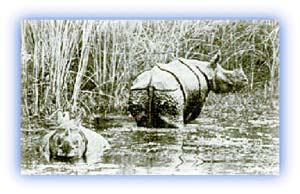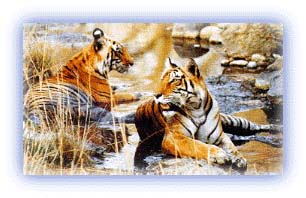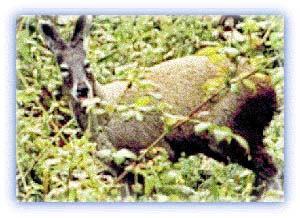Flora and fauna
General Info
· Flora
· Tropical Forests
· Temperate Forests
· Sub-alpine forests
· Alpine scrubs
· Fauna
· Mammals
· Birds
How much money do the poachers make?
Protected Areas
· Nepal
· India

![]()
|
Why are these animals endangered? The forest is the natural habitat of animals. However, most of the forests, in some way or the other, are used by humans because it is the source of living for people in the rural areas. As the human population increased and the pressure on the forests grew, humans started encroaching on forest territory. As a result, the forests quickly dwindled. The wild animals in Nepal, for example,have lost much of their natural. Loss of habitat is however, just one of thereasons animalsare disappearing. |
A major threat to the animals is poaching. Poachers have been largely responsible for making wildlife populations dwindle. Animals like tigers, leopards, rhinos, bears and musk deer have been killed by poachers for making money.
 |
| One horned Rhino Credit: Mahabir Pun |
Rhinos
The Rhinoceros are mainly killed for their horns. A rhino's horn sell
for thousands of dollars. In Arabian countries, especially
in North Yemen, the rhino's horns are mainly used for making handles of
daggers. In oriental countries they are used for
making traditional medicines for headache, cold and flu.
 |
| Tigers at the Corbett National Park, India Credit: Karamjeet Singh |
Tigers
Tigers and leopards are killed for their superb coats and bones. The
bones are used in Chinese and Japanese traditional
medicine. Official figures put the the total number of tigers in India
to be close to 5000. However experts on the topic and
independent sources say that the actual figure may be closer to 3000
than 5000. There is a rising demand for tiger related
goods. Tiger skins and bones are in heavy demand. Poachers and smugglers
have established a clever route by
which tigers surface in the form of medicines and balms in Chinese
markets as Chinese "medicine". Not a year goes by without
stories of seizures of bones and skins by the customs officials. But
these seizures are only the tip of the iceberg and the
poaching still continues.
 |
| Musk Deer Credit: Mahabir Pun |
Musk Deer
Musk deer are hunted for musk, a powdery substance which the male musk
deer secretes from a gland in the abdomen. This
is a highly valued item for perfumes and medicines. Chinese use the musk as a folk medicine and believe it has aphrodisiac
properties.
Himalayan Black Bear
The Himalayan black bear is also endangered. They are killed for their
gall bladder which provide the ingredients of one of
the most coveted oriental medicines.
All rights reserved